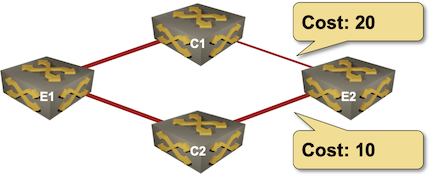Does Unequal-Cost Multipathing Make Sense?
Every now and then I’m getting questions along the lines “why doesn’t X support unequal-cost multipathing (UCMP)?” for X in [ OSPF, BGP, IS-IS ].
To set the record straight: BGP does support some rudimentary form of unequal-cost multipathing with the DMZ Bandwidth community, but it only works across multiple egress points from a single autonomous system. Follow-up nerd knobs described how to use the same community over EBGP sessions; not sure whether anyone implemented that part (comments welcome).
Repost: Using MP-TCP to Utilize Unequal Links
In the Does Unequal-Cost Multipathing Make Sense blog post I wrote (paraphrased):
The trick to successful utilization of unequal uplinks is to use them wisely […] It’s how multipath TCP (MP-TCP) could be used for latency-critical applications like Siri.
Minh Ha quickly pointed out (some) limitations of MP-TCP and as is usually the case, his comment was too valuable to be left as a small print at the bottom of a blog post.
Unequal-Cost Multipath in Link State Protocols
TL&DR: You get unequal-cost multipath for free with distance-vector routing protocols. Implementing it in link state routing protocols is an order of magnitude more CPU-consuming.
Continuing our exploration of the Unequal-Cost Multipath world, why was it implemented in EIGRP decades ago, but not in OSPF or IS-IS?
Ignoring for the moment the “does it make sense” dilemma: finding downstream paths (paths strictly shorter than the current best path) is a side effect of running distance vector algorithms.
Using Unequal-Cost Multipath to Cope with Leaf-and-Spine Fabric Failures
Scott submitted an interesting the comment to my Does Unequal-Cost Multipath (UCMP) Make Sense blog post:
How about even Large CLOS networks with the same interface capacity, but accounting for things to fail; fabric cards, links or nodes in disaggregated units. You can either UCMP or drain large parts of your network to get the most out of ECMP.
Before I managed to write a reply (sometimes it takes months while an idea is simmering somewhere in my subconscious) Jeff Tantsura pointed me to an excellent article by Erico Vanini that describes the types of asymmetries you might encounter in a leaf-and-spine fabric: an ideal starting point for this discussion.
Single-Metric Unequal-Cost Multipathing Is Hard
A while ago, we discussed whether unequal-cost multipathing (UCMP) makes sense (TL&DR: rarely), and whether we could implement it in link-state routing protocols (TL&DR: yes). Even though we could modify OSPF or IS-IS to support UCMP, and Cisco IOS XR even implemented those changes (they are not exactly widely used), the results are… suboptimal.
Imagine a simple network with four nodes, three equal-bandwidth links, and a link that has half the bandwidth of the other three:

Unequal-Cost Multipath with BGP DMZ Link Bandwidth
In the previous blog post in this series, I described why it’s (almost) impossible to implement unequal-cost multipathing for anycast services (multiple servers advertising the same IP address or range) with OSPF. Now let’s see how easy it is to solve the same challenge with BGP DMZ Link Bandwidth attribute.
I didn’t want to listen to the fan noise generated by my measly Intel NUC when simulating a full leaf-and-spine fabric, so I decided to implement a slightly smaller network:
